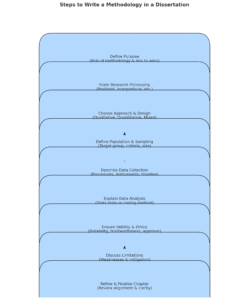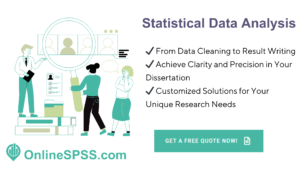How to Write a Methodology in a Dissertation
The methodology chapter of a dissertation is one of the most important sections because it explains exactly how you carried out your research. Unlike the introduction or literature review, which describe context and background, the methodology is about process. It tells readers what research design you used, how you collected your data, how you analysed it, and why you made these choices. Writing it well is critical, as examiners want to see evidence of rigour, transparency, and consistency.
In this guide, we will walk through everything you need to know about writing a strong dissertation methodology chapter.
Discover our complete dissertation guide series: [Abstract], [Introduction], [Literature Review], [Methodology], [Results], [Conclusion], [Discussion], [References], and [Appendix].
What Is the Methodology Chapter?
The methodology chapter describes how you conducted your research. This includes details about your research design, data collection methods, sampling strategies, ethical considerations, and analytical procedures. It should give your reader enough information to understand, replicate, or critique your research process. Unlike a methods section in a journal article, the dissertation methodology goes beyond listing tools and techniques. It explains the reasoning behind each choice and shows how your approach aligns with your research questions and philosophical assumptions.

Why the Methodology Chapter Matters
The methodology serves as the backbone of your dissertation. Without it, your findings could appear untrustworthy. It ensures transparency so that other researchers can replicate your work if needed. It also allows examiners to judge whether your methods are appropriate for answering your research questions.
A strong methodology demonstrates:
That you understand different research traditions and approaches
That your data collection and analysis methods are appropriate
That you considered reliability, validity, and ethics carefully
What to Include in the Methodology Section
Your methodology should follow a clear and logical structure. The typical components include:
1. Research Philosophy and Approach
Your methodology should begin by explaining the philosophical underpinnings of your research. This means stating whether your study is guided by:
Positivism – assumes reality is objective and measurable; common in quantitative studies
Interpretivism – assumes reality is socially constructed; common in qualitative studies
Pragmatism – focuses on practical solutions; common in mixed-method studies
This section helps readers understand how you view knowledge and why you chose particular methods.
2. Research Design
Research design refers to the overall strategy you adopt to integrate the components of the study. Examples include:
Experimental designs (used in sciences to test causal relationships)
Cross-sectional designs (data collected at one point in time)
Longitudinal designs (data collected across time)
Case study designs (in-depth exploration of a specific case or setting)
Ethnography (immersive observation of cultures or groups)
Choose the design that best aligns with your research problem and explain why it is appropriate.
3. Data Collection Methods
You must provide detailed information on how you gathered your data. Examples include:
Surveys and questionnaires
Interviews (structured, semi-structured, or unstructured)
Focus groups
Experiments or simulations
Observations
Archival research or secondary data analysis
For each method, explain how it was carried out, why it was chosen, and what instruments (e.g., interview guides, survey tools) you used.

4. Sampling Strategy
Sampling refers to how you selected participants or data points. Common strategies include:
Probability sampling (random selection for representativeness)
Purposive sampling (selecting participants relevant to your study)
Convenience sampling (choosing those easily accessible)
Snowball sampling (participants recruit others)
You should state your sample size, justify it, and explain inclusion and exclusion criteria.
5. Data Analysis Procedures
Clearly state how you analysed your data. Examples include:
Quantitative: descriptive statistics, inferential tests (t-test, ANOVA, regression)
Qualitative: thematic analysis, discourse analysis, grounded theory coding
Mixed methods: integrating statistical results with qualitative themes
Explain the steps in your analysis process, not just the software you used (e.g., SPSS, NVivo, R).
6. Ethical Considerations
Ethical approval is often required for studies involving human participants. Summarise:
- How consent was obtained
- How anonymity and confidentiality were maintained
- Any ethical risks and how they were mitigated
- Institutional Review Board (IRB) or ethics committee approvals
Even in studies using secondary data, ethical dimensions such as data protection or the use of sensitive content should be addressed.
7. Limitations of the Methodology
No study is perfect, and acknowledging limitations strengthens credibility. Common limitations include:
Small or non-representative samples
Limited access to data
Time or resource constraints
Potential biases in data collection
Briefly explain these and show how you minimised their impact.
Tips for Writing a Strong Methodology Chapter
- Be precise and detailed. Avoid vague descriptions like “I interviewed some people” or “data were analysed using standard methods.” Specify exactly what you did and why.
- Justify every decision. Don’t just describe your methods—explain why they were the best fit for your research problem.
- Align with your research questions. Every methodological element should connect logically to your aims and questions.
- Be consistent with your epistemology. Your methods should reflect your philosophical assumptions. A constructivist study should not rely on rigid statistical metrics without explanation.
- Use academic sources. Support your methodological choices with citations from research methods literature.

What Writing Style Works Best for the Methodology Chapter?
The methodology should be written in the past tense, since you are reporting what you already did. Use clear, concise, and precise language. Avoid overly technical jargon unless necessary. Each subsection should logically flow into the next, and transitions should highlight why methods were chosen.
Common Mistakes to Avoid
- Writing a generic methods section without tailoring it to your research
- Failing to explain how data were analysed
- Using inconsistent terminology across chapters
- Omitting limitations or ethical considerations
- Overloading the section with technical jargon without clear explanation








